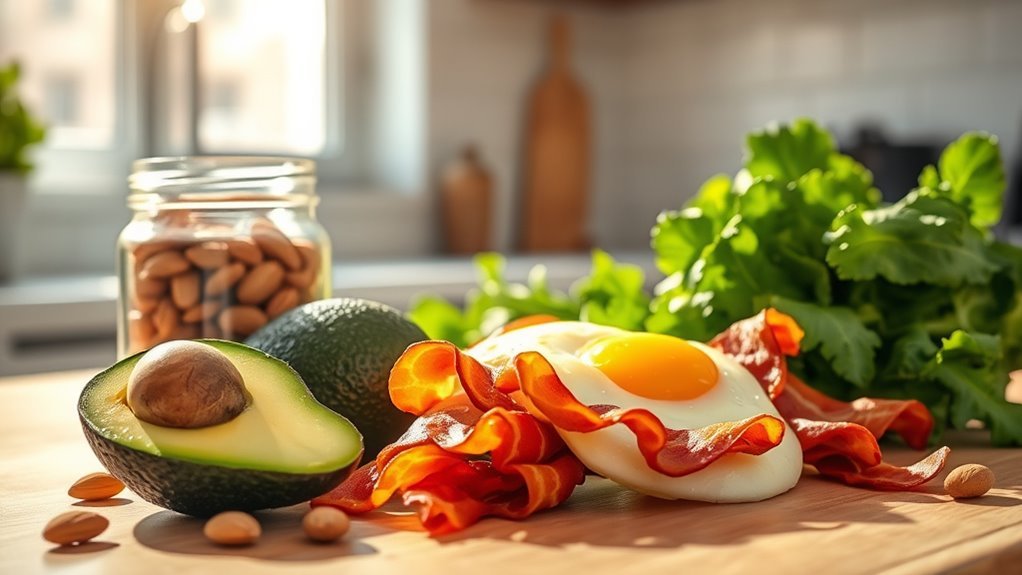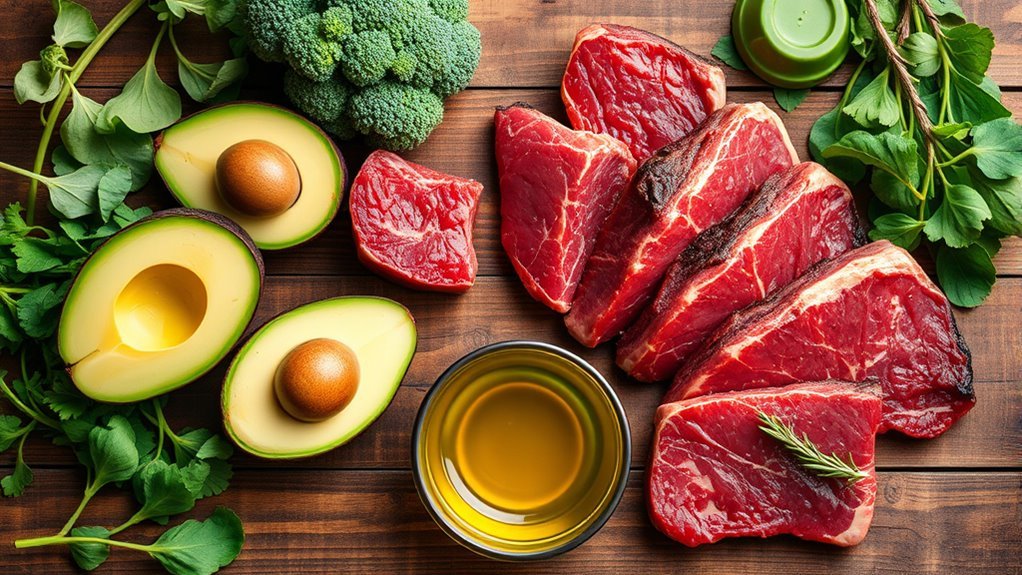The keto diet is a high-fat, low-carbohydrate eating plan that shifts your body into ketosis, a state where you burn fat for energy instead of carbs. With around 70-75% of your calories coming from fat and only 5-10% from carbs, it promotes weight loss and improved mental clarity. While effective, it can come with challenges and side effects. If you want to explore the benefits and details further, there’s much more to uncover.
Understanding Ketosis

When you follow a keto diet, your body enters a state called ketosis, which is vital for understanding how this dietary approach works. In ketosis, your body shifts from using carbohydrates for energy to burning fat, leading to ketosis benefits like weight loss and improved mental clarity. However, it’s important to address ketosis misconceptions. Many believe that ketosis is unhealthy or unsustainable, but research indicates that, when done correctly, it can be a safe and effective way to improve metabolic health. Remember, individual experiences can vary, so it’s important to listen to your body and consult with a healthcare professional if you’re unsure. Embracing this knowledge empowers you to make informed choices on your keto journey.
The Macronutrient Breakdown

In the keto diet, understanding the macronutrient breakdown is essential for achieving and maintaining ketosis. You’ll typically aim for a high fat intake, making up about 70-75% of your daily calories, while keeping carbohydrates to around 5-10%. This balance not only supports fat burning but also helps regulate energy levels and overall health.
Ideal Macronutrient Ratios
Understanding the ideal macronutrient ratios is essential for anyone looking to succeed on a keto diet, as it directly influences your body’s ability to enter and maintain ketosis. Typically, keto ratios suggest that about 70-75% of your daily calories should come from fats, 20-25% from protein, and just 5-10% from carbohydrates. Focusing on healthy fat sources, like avocados, nuts, and olive oil, can help you meet these ratios while ensuring nutritional balance. Protein should be moderate, as excessive intake can be converted to glucose, hindering ketosis. By carefully managing these macronutrient ratios, you can enjoy the freedom of diverse food choices while effectively promoting fat adaptation and overall health on your keto journey.
Importance of Fat Intake
Fat serves as the cornerstone of the ketogenic diet, playing an essential role in achieving and maintaining ketosis. To optimize your fat intake, consider these key aspects for effective meal planning:
- Choose Quality Fat Sources: Focus on healthy fats like avocados, nuts, and olive oil.
- Maintain Energy Levels: Consuming adequate fats helps sustain your energy throughout the day, preventing crashes.
- Ensure Dietary Balance: While fat is vital, include moderate protein and low-carb vegetables to keep your meals balanced.
- Experiment with Ratios: Adjust your fat intake based on how your body responds, ensuring you stay in ketosis.
How the Keto Diet Works

When you follow a keto diet, your body undergoes a significant metabolic shift known as ketosis. This process occurs when you drastically reduce carbohydrate intake, prompting your body to turn to fat for fuel instead. The keto diet mechanisms involve the breakdown of fatty acids into ketones, which serve as an alternative energy source. As you adapt, your body experiences metabolic adaptation, becoming more efficient at burning fat rather than glucose. This shift can lead to stabilized energy levels and reduced hunger, as fat is a more sustained energy source. Understanding these processes can empower you to make informed choices about your dietary habits while enjoying the freedom that comes with a new approach to eating.
Benefits of the Keto Diet
As your body adapts to ketosis, you may start to notice several benefits associated with the keto diet:
- Weight Loss: You’ll likely experience effective weight loss as your body burns fat for fuel instead of carbs.
- Mental Clarity: Many report improved mental clarity and focus, as ketones provide a steady energy source for your brain.
- Energy Levels: You’ll often find your energy levels more stable, reducing those pesky energy crashes.
- Metabolic Health: The keto diet can enhance metabolic health, potentially improving heart health, regulating blood sugar, and promoting inflammation reduction while preserving muscle.
These benefits can empower you to take control of your health and well-being, making the keto diet an appealing option for many seeking freedom in their lifestyle choices.
Potential Challenges and Side Effects
While the keto diet offers various benefits, it’s important to evaluate potential challenges and side effects you might experience. Common side effects like fatigue and digestive issues can occur, and there’s a risk of nutritional deficiencies if you’re not careful with your food choices. Additionally, many people find long-term adherence to the diet difficult, which can impact its sustainability for lasting results.
Common Side Effects
Although the keto diet can lead to significant weight loss and improved metabolic health, it’s important to be aware of its potential side effects. Here are some common challenges you might encounter:
- Keto flu: As your body adjusts, you may experience fatigue, headaches, and irritability.
- Electrolyte imbalance: Reduced carb intake can disrupt your sodium, potassium, and magnesium levels, leading to cramps and dizziness.
- Digestive issues: A sudden increase in fats can cause bloating, constipation, or diarrhea.
- Energy fluctuations: You might notice varying energy levels, mood swings, and cravings management challenges as your body adapts.
Staying mindful of your hydration needs and nutrients can help mitigate these side effects, ensuring a smoother journey on your keto path.
Nutritional Deficiencies Risks
The shift to a keto diet can markedly alter your nutritional intake, which might lead to deficiencies if not carefully managed. With strict dietary restrictions, you may find your food variety diminished, impacting nutrient absorption. This can result in vitamin deficiencies, particularly B vitamins and vitamin C, as well as mineral imbalances like magnesium and potassium, leading to potential electrolyte issues. These deficiencies can affect your long-term health and overall well-being. Additionally, the metabolic impact of a keto diet can vary from person to person, making it essential to monitor your nutrient intake closely. Balancing your meals with a diverse range of low-carb foods can help mitigate these risks while ensuring you enjoy the freedom of a keto lifestyle.
Long-term Sustainability Issues
As you consider adopting a keto diet for the long term, it’s essential to recognize potential sustainability issues and side effects that may arise. Here are some challenges you might face:
- Long-term adherence: Sticking to a strict low-carb regimen can be tough, leading to potential dropouts.
- Psychological impacts: The diet’s restrictions can affect your relationship with food, possibly causing anxiety or cravings.
- Social dynamics: Maneuvering social events can be challenging, as many meals don’t align with keto guidelines.
- Meal planning: Consistently preparing keto-friendly meals requires time and effort, which may not always fit into your lifestyle integration.
Being aware of these factors can help you make informed choices about your long-term keto journey.
Foods to Eat on a Keto Diet
When starting on a keto diet, it’s crucial to focus on foods that will help you maintain a state of ketosis, where your body burns fat for fuel instead of carbohydrates. Incorporate healthy fats like avocados and olive oil, as well as protein sources such as eggs, chicken, and fatty fish. Low carb vegetables, like spinach and zucchini, are great additions too. For keto-friendly snacks, consider nuts or cheese. Meal prep can simplify your week, allowing you to whip up delicious keto desserts like almond flour cookies. Don’t forget to explore snack ideas that keep you satisfied without carbs. Finally, some cooking tips include using herbs and spices to enhance flavors without adding extra carbs. Enjoy your journey!
Foods to Avoid on a Keto Diet
Maintaining a state of ketosis goes beyond choosing the right foods; it also involves avoiding certain items that can hinder your progress. Here are four foods you should steer clear of:
Achieving ketosis requires careful food selection and avoidance of certain items that can impede your journey.
- Sugary snacks – These can sabotage your carb counting efforts and spike your insulin.
- Starchy vegetables – Items like potatoes and corn are high in carbs and should be limited.
- Grains – Bread, pasta, and rice contain hidden carbs that can disrupt your ketosis.
- Processed foods – Always read labels, as many contain sugar alternatives and hidden carbs.
When meal planning or dining out, consider recipe substitutions and practice portion control to stay on track. Remember, freedom on a keto diet comes from making informed choices!
Different Types of Keto Diets
While the traditional ketogenic diet focuses on high fat, moderate protein, and very low carbohydrate intake, there are several variations that cater to individual preferences and health goals. The Standard Keto is the classic approach, while Targeted Keto allows for carbs around workouts. Cyclical Keto includes periods of higher carb intake, ideal for athletes. If you prefer more protein, High Protein Keto might suit you better. Vegetarian and Mediterranean Keto cater to plant-based eaters, emphasizing whole, natural foods. For those seeking simplicity, Lazy Keto minimizes tracking, while Dirty Keto focuses on low-carb convenience foods without concern for quality. Each variation offers unique benefits, so you can choose one that aligns with your lifestyle and goals.
Tips for Starting a Keto Diet
As you commence your keto journey, it is essential to prepare yourself both mentally and physically to maximize your chances of success. Here are some tips to help you get started:
- Meal planning: Create a weekly menu focused on low-carb, high-fat meals. This helps you stay on track and reduces the temptation of unhealthy choices.
- Grocery shopping: Stock up on keto-friendly foods like avocados, nuts, and leafy greens. Having these on hand makes it easier to stick to your diet.
- Stay hydrated: Drink plenty of water to help manage cravings and maintain energy levels.
- Educate yourself: Read up on the science behind keto to understand how it works and why it may benefit you.
With these steps, you’ll feel more empowered on your keto journey.


